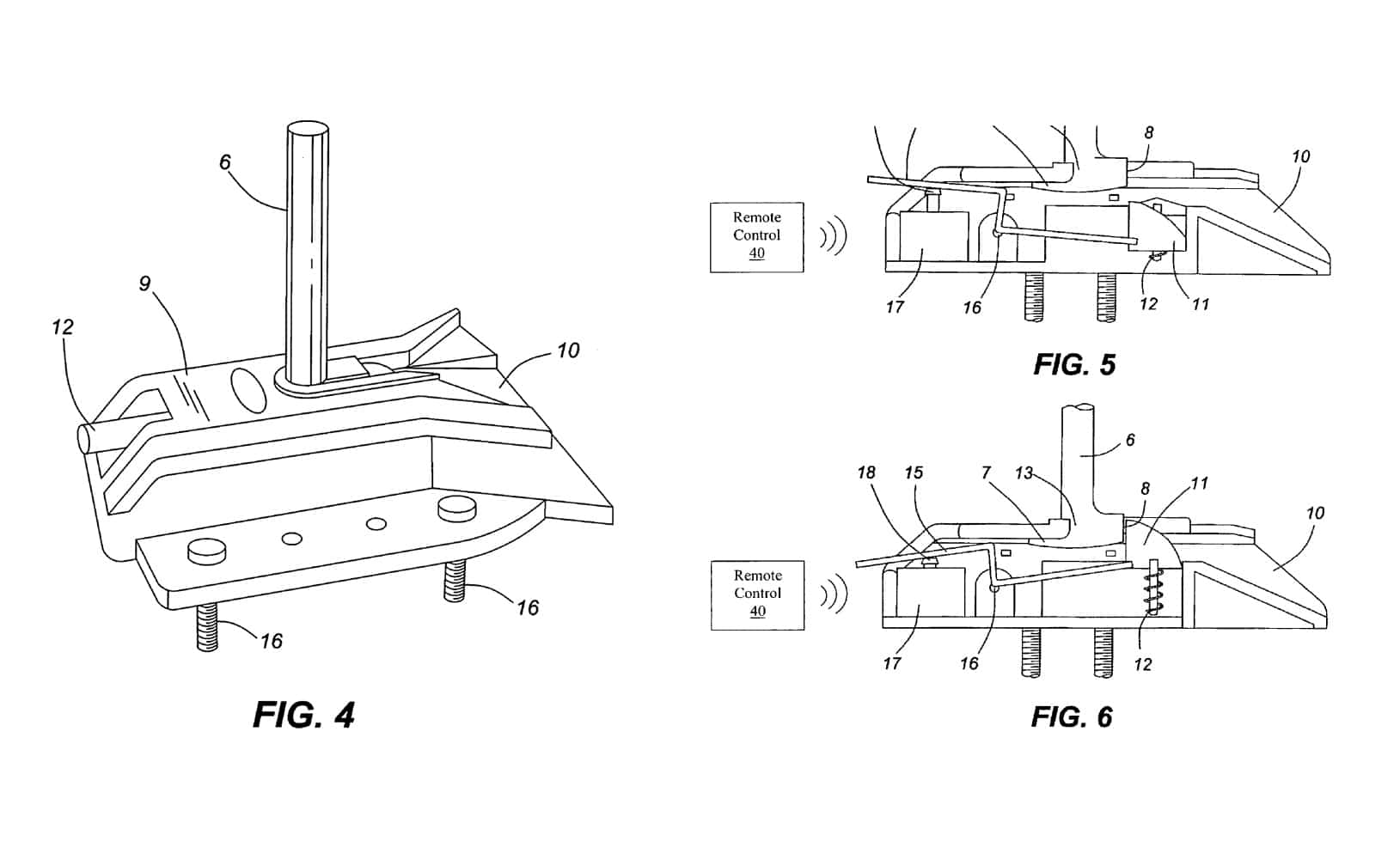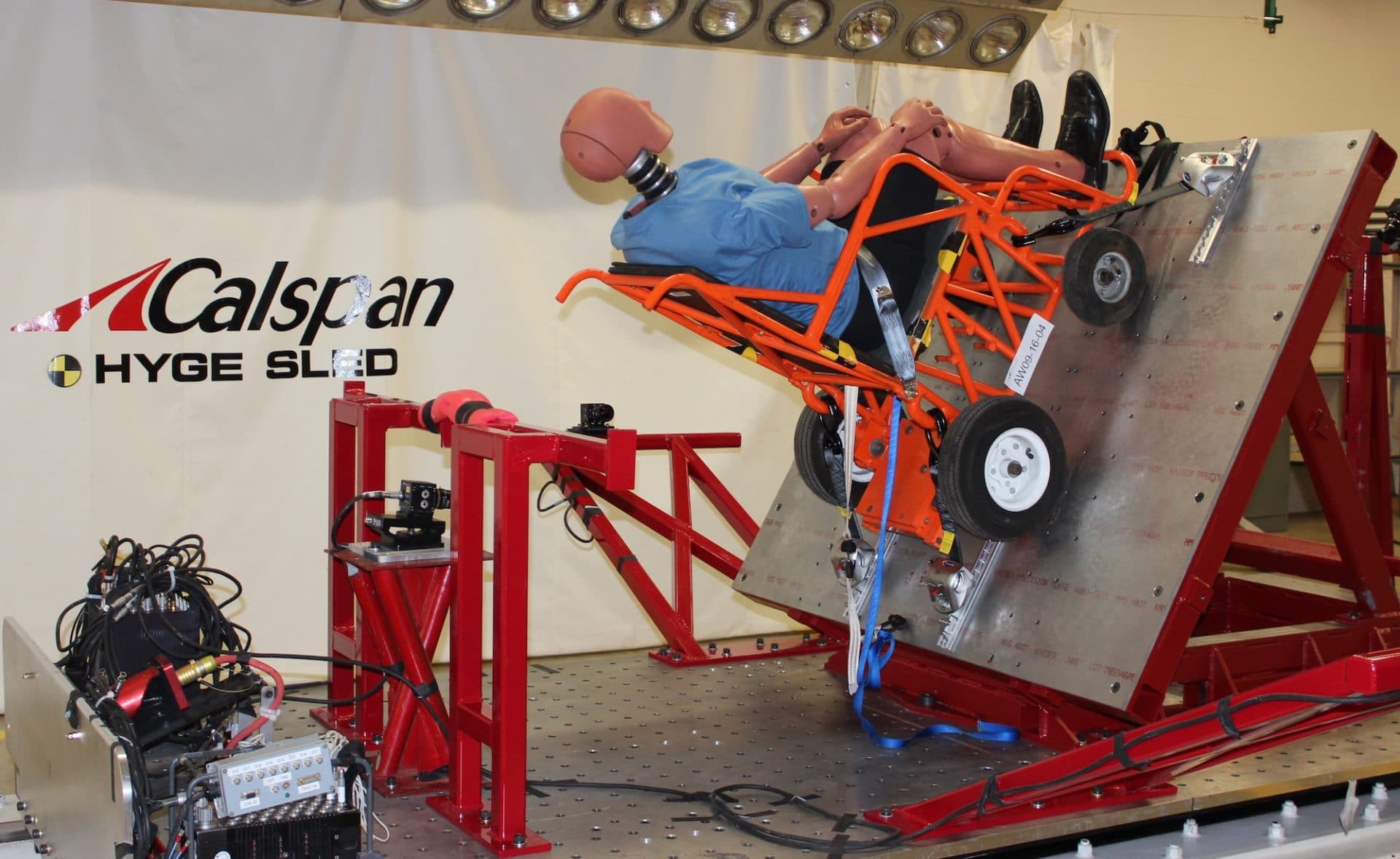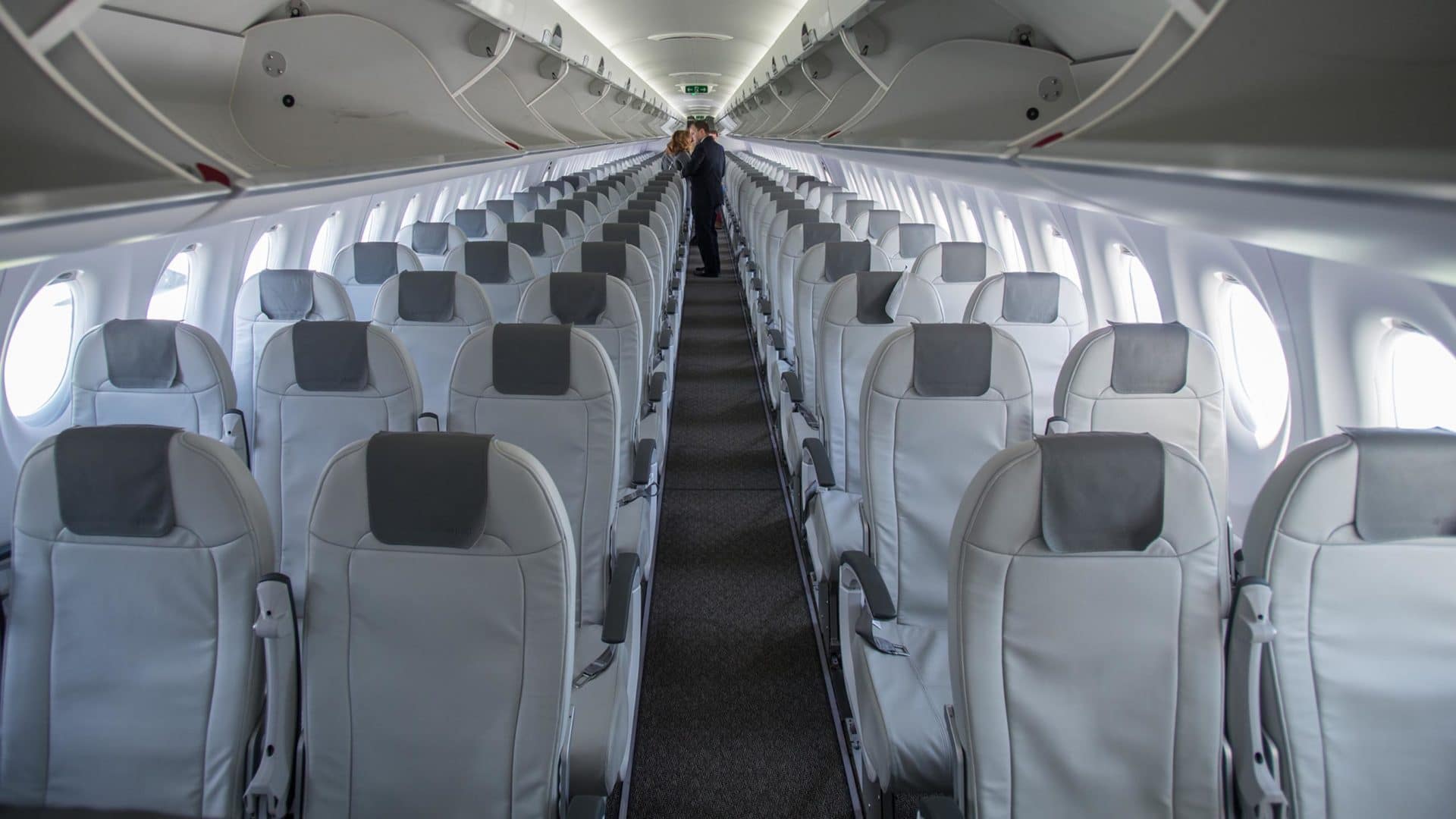The Physics, Economics, and Politics of Wheelchairs on Planes
When Shane Burcaw flies on an airplane, he brings along a customized gel cushion, a car seat, and about 10 pieces of memory foam. The whole arsenal costs around $1,000, but for Burcaw it’s a necessity.
The 27-year-old author and speaker — who, alongside his fiancée, Hannah Aylward, is one half of the YouTube duo Squirmy and Grubs — has spinal muscular atrophy, a genetic disorder that affects motor neurons and causes muscle wasting and weakness. The disorder contorted his limbs and he has used a wheelchair for mobility since he was 2 years old. Today, he uses a motorized wheelchair custom-fitted to his diminutive, 65-lb. frame, but to board an airplane, he’s required to give it up. Instead, Aylward must carry Burcaw onto the plane, and from there, transfer him into a child’s car seat, which provides limited support and does not fit his body (thus, the foam).
“When you hear about the injuries and the discomfort and the embarrassment that wheelchair users have faced when flying,” Burcaw said, “it becomes pretty obvious that they’re not being treated in a very humane way with these rules.”
Indeed, regulations prohibit passengers from sitting in their own wheelchairs on planes, and, as a result, 29 years after the passage of the Americans with Disabilities Act (ADA), which dramatically increased American wheelchair users’ access to buses, trains, and other essential 21st century infrastructure, airplanes remain stubbornly inaccessible. For many wheelchair users, the experience of flying is stressful, painful, and sometimes humiliating. For some, it is simply impossible.
Emily Ladau, a disability rights activist, writer, and public speaker, does deep-breathing exercises to manage her anxiety as airport staff take her wheelchair away. She likens the experience to watching someone walk off with her legs. Things aren’t much better onboard. “Airplane seats are designed for the quote-unquote average person,” Ladau said. “I’m nowhere near the quote-unquote average person.” At 4’6”, she does not fit the seat easily. Her legs dangle. She cannot align her posture. “It’s very uncomfortable,” she said.
The explicit rationale behind the regulations involves safety. Last year, in response to questions about wheelchair access, a major airline industry group told Aviation Week that “aircraft seats are constructed to meet rigorous safety regulations that include survivability at several times the force of gravity. So at the present time, these certified aircraft seats are the only permissible seating for all passengers.”
The group went on to explain that such certification is not imposed on other modes of transport. “This is why trains or buses, for instance,” the group said, “can accommodate a wider range of options.”
But a closer look at the history and science of airplane — and wheelchair — safety tells a more complicated story. It is true that airplane seats can withstand forces several times the force of gravity. But so can wheelchair restraint systems — and in many cases, they are tested to a more exacting standard than your typical airplane seat.
That discrepancy — along with a growing chorus of advocates arguing that the experiences of wheelchair users like Ladau and Burcaw are unacceptable — has spurred a new push to finally make air travel more fair and accessible. Whether and how soon that might happen, however, is difficult to say. The ADA, after all, specifically excludes air travel from the accommodations it prescribes for other forms of public transit. And in any event, carving out a place for wheelchairs on commercial aircraft depends on the same complex blend of economics, politics, and physics that underlies every square inch of airplane design.
For disability advocates, however, change cannot come soon enough.
“You’re basically giving disabled people yet another reason to feel like society wants us shut into our homes and doesn’t want us going anywhere,” said Ladau, adding: “It’s time to quit shutting us out of such a ubiquitous mode of travel.”
In a video published in June, Shane Burcaw decries what he calls airlines’ discrimination against wheelchair users.
Airplane safety standards have a long, fractious history in the United States. Those narrow, reclining seats have been subject to decades of fierce debate among industry players, regulatory bodies, and experts in crash survivability, all arguing over what design, exactly, best balances the competing needs of cost, weight, and safety.
Horrific crashes may capture the public imagination, but the majority of airplane accidents are, in fact, survivable. “Most people think, ‘If I’m in an airplane crash, I’m going to die.’ And nothing could be further from the truth,” said Dennis Shanahan, a surgeon, pilot, and air crash survivability expert with decades of military and private sector experience. Shanahan estimates that 85 percent of crashes are “quite survivable,” including crash landings, tarmac incidents, and lower-speed crashes during takeoff and landing.
When a plane makes impact with the ground or the water, the curved aluminum alloy of the fuselage helps protect occupants from the blow. But the rapid deceleration also produces tremendous forces inside the plane, warping and tearing up seats, slinging loose luggage around the cabin, and throwing occupants forward, like so many eggs knocking together.
To limit that damage, in the 1950s regulators began requiring commercial airplanes to have seats that could withstand forces nine times greater than the force of gravity, or 9 Gs. But, by the 1970s, the National Transportation Safety Board had begun to express concerns that these seats were performing poorly. In 1987, Congress charged the Department of Transportation with exploring seat safety, and, the next year, the Federal Aviation Administration issued a rule requiring all newly designed airplanes to incorporate 16 G seats. On top of that, the FAA floated two provisional rules — one that would require all newly manufactured planes, even using old designs, to use 16 G seats, and another requiring airlines to retrofit their existing planes with the upgraded seats.
The aviation industry responded with dismay, particularly around the perceived difficulty of meeting new head-impact safety standards. The new seats would also be more expensive and heavier to carry, increasing fuel costs in an industry that often runs on small profit margins. In the face of industry backlash, the FAA announced that it would delay the provisional rules.
In order to justify the safety benefits of 16 G seats, the FAA commissioned RGW Cherry and Associates, a British aerospace engineering consulting firm, to produce an independent estimate of whether or not 16 G seats would save many lives. The Cherry team did an exhaustive database search looking for serious crashes that had been deemed survivable and that involved U.S.-regulated planes lacking 16 G seats. The consultants identified 25 crashes to analyze between the years of 1984 and 1998. The resulting report, released in 2000, documents in forensic detail how seats buckled and warped under pressure, crushing passengers’ legs and cracking their vertebrae. An upgrade to 16 G seats, the researchers estimated, would have saved between 41 and 83 lives and prevented between 34 and 97 serious injuries.
In delicate language, the FAA converted those lives saved and injuries averted into a dollar value and then balanced that final total against the cost of upgrading the country’s aviation fleet with 16 G seats. The analysis came out in favor of an upgrade.
According to FAA records, industry leaders, especially Boeing, vigorously contested the findings. Representatives of Boeing argued that the cost-benefit analysis was inaccurate because plane travel had grown safer overall, and that the Cherry report was mostly “guesswork.” (Today, a post on the company’s website lists 16 G seats among the safety features that define modern aviation).
In response to industry pressure and the events of September 11th, 2001, the FAA continued to delay a ruling. Its final decision, issued in 2005, gave airlines four years to become compliant with standards on newly manufactured planes. (It also removed any requirement to retrofit planes with 16 G seats, meaning that, in theory, old planes could still be flying today with 9 G seats.)
In September 2009 — more than 22 years after Congress requested new seat guidelines, and nearly 30 years after the National Transportation Safety Board issued its formal recommendation — the 16 G change went fully into effect for new airplanes.
But according to Shanahan, the crash survivability expert, even that standard is a compromise. U.S. military testing shows that upgraded lap-belt restraints could allow many people to survive impacts as high as 25 Gs. High-tech restraint systems in race cars have even allowed people to withstand forces upwards of 100 G. “We’re making a conscious compromise on saving individuals from crashes,” says Shanahan. “And one has to do, for practical and economic reasons.”
In other words, airplane seats today are the culmination of years of discord and ultimate compromises that blend concerns for both safety and cost. Adding wheelchairs to the mix was always going to be complicated — and it would require a grassroots approach on the part of advocates to get even preliminary research on that front off the ground.
Eight years ago, Michele Erwin wanted to take her son, Greyson, on a trip from their home on Long Island, New York to Disney World in Orlando, Florida. Greyson, now 12, also has spinal muscular atrophy, and Erwin, who is able-bodied, says she learned quickly on that trip how difficult air travel can be for wheelchair users — and she worried that as her son grew, flying might well become impossible.
The experience sent Erwin online where she began reading in earnest about wheelchair restraint systems. It wasn’t long, she recalls, before she came across a news release announcing that a system built by Q’Straint, a wheelchair securement company based in Florida, had recently passed a test exposing it 20 Gs.
“I’m not an engineer,” Erwin said. “I am just this mom, who, quite honestly, works in the apparel industry. And I was like, ‘Wow, what’s the standard for airplane seats?’”
When she learned it was only 16 Gs, Erwin got in touch with Q’Straint to ask if they were working on airplane-specific systems. They were not. She also contacted the Federal Aviation Administration and was told that the agency didn’t have the funding to test the restraints. So Erwin decided to tackle the issue herself. She started All Wheels Up, a nonprofit organization dedicated to funding and conducting the initial research into wheelchair-accessible air travel.
In most years, All Wheels Up operates on a budget of less than $20,000, relying on donors to supply the equipment for testing. Erwin, the president, does not draw a salary, and the organization has no paid staff. They spent their first round of fundraising on an animation to help people visualize a wheelchair accessible plane. From there, they began lobbying members of Congress, backing a provision for a feasibility study introduced into the 2016 FAA Reauthorization Act. The provision — introduced by the Paralyzed Veterans of America, a congressionally chartered service organization — was ultimately struck from the bill, which ended up stalling in Congress anyway.
“I have days when I’m like, I just can’t do this anymore, I’m going to quit,” Erwin said. “There are days when I have absolutely no money in the bank account, and I’m working 40 hours a week on this, and I’m like, ‘Am I the only person who cares?’”
Then she gets a nice note or a small donation, which she says pushes her forward — and indeed, a growing number of wheelchair users are invested in her fight. In the decades that the FAA and the airline industry were wrangling over seat standards, flying was becoming a much more common and accessible part of American life. Ticket prices dropped steadily after industry deregulation in the 1970s, and by the late 1990s, close to 50 percent of Americans took at least one flight per year, according to Gallup survey data.
This animation by All Wheels Up shows an example of what the group hopes wheelchair accessible air travel may look like.
At the same time, transportation infrastructure was becoming more accessible. The Americans with Disabilities Act, passed in 1990, and supplemented by final regulations from the Department of Transportation, imposed significant requirements on public bus systems, trains, and some private bus and taxi fleets when it comes to making accommodations for people with disabilities, including wheelchair users. But the legislation does not extend to air travel.
Instead, air carriers have to comply with a separate piece of legislation, the Air Carrier Access Act. William Goren, an attorney specializing in disability access law, says that law gives the Department of Transportation a lot of leeway to set its own rules, and offers few routes for disabled travelers to seek redress when they feel their rights have been violated. “If something goes wrong, the plaintiff really has no recourse,” Goren said.
The result is that air travel remains challenging or impossible for many wheelchair users. Tiara Simmons Mercius, a legal assistant and disability rights activist in California, for example, says she she has largely stopped flying at all — in part out of fear that her wheelchair will be damaged by baggage handlers or in transit, a common occurrence that can create serious mobility issues. That may sound like a personal choice, but for Simmons Mercius and thousands like her, it’s one that they feel they are forced into by circumstance. “That choice is being influenced by the fear that my medical equipment will be broken by the time I get off the plane,” she said, “and I will be stuck.”
If Erwin and other advocates are successful, such stark tradeoffs might one day become a thing of the past — particularly as technological advances, and even current realities, begin to challenge the safety justifications for keeping wheelchairs off planes in the first place. Indeed, as the ADA pushed transit systems around the country to become more accessible, it also expanded the market for wheelchair restraint systems. Companies like Q’Straint, which was founded in 1984, began to design and sell sophisticated systems for restraining wheelchairs in automobile accidents. Some of these systems use straps, similar to seatbelts, to hold a wheelchair in place under the strain of a crash. Others use mechanisms that temporarily secure the chair to the vehicle floor.

Because vehicular crashes can be extremely violent, there was pressure for wheelchair manufacturers and wheelchair restraint system designers to meet high crash standards. The federal government does not issue binding standards for wheelchair and wheelchair restraint crash safety, but widely accepted voluntary guidelines, developed by the Rehabilitation Engineering and Assistive Technology Society of North America, or RESNA, require manufacturers to test their products against what’s called a 20 G/30 mile-per-hour standard.
In a 20 G/30 mph test, a chair or its restraint is exposed to a 30 mph change of velocity in less than one-tenth of a second, generating forces 20 times that of gravity. A 200-pound chair with a 150-pound dummy would, during the test, briefly experience forces upwards of 3.5 tons.
If this sounds more rigorous than airplane seat standards, that’s because it is. “Most of the requirements for an airline seat, in terms of its strength and crash response, are less stringent than for vehicle seats,” said Miriam Manary, a lead engineer at the University of Michigan Transportation Research Institute. Manary, an expert in the crashworthiness of wheelchairs and wheelchair restraints, also helps write the RESNA standards.
“A lot of the characteristics you’d need to have a wheelchair serve as a successful airplane seat are already happening in what we’re doing making them suitable for motor vehicle seats,” she said.
Still, the precise angles and specifications used to test airline seats are different from those applied to wheelchairs. And that’s where Erwin, in her quest to have the efficacy of Q’Straint’s wheelchair restraint systems tested for air travel, thought she could make a difference. “I Googled ‘FAA-approved crash test facilities.’ And I think I called three or four,” Erwin recalled. “And Calspan was the one that actually agreed to doing the test.”
Calspan, a facility in Buffalo, New York, has been testing aviation equipment since the 1940s. No one had ever tried to run aviation-style tests on wheelchairs before, but they were willing to give it a try. Q’Straint donated a surrogate chair made of welded steel tubing and plates for the testing. These chairs can be fitted with various seating systems and can be reused in multiple tests. Erwin commissioned a custom-made sled to hold it and run it down the testing track.
In September 2016, Erwin flew from Texas — where she now lives — to Buffalo. There, she and the Calspan team got to work, testing two different Q’Straint securement systems against the specifications that the FAA recommends for airplane seats. The Calspan team placed a test dummy on the surrogate wheelchair, itself secured to the sled. The engineers then pumped pressurized gas into a cylinder and with the release of a final pulse of highly pressurized air, propelled a plunger-like arm forward in the space of a few milliseconds. The arm rapidly accelerated the dummy and the chair, briefly placing them under forces of up to 16 Gs. All of the wheelchair restraint systems met the FAA seat standard.
When Erwin returned to Calspan in January of this year — this time to test the setup using actual wheelchair models rather than a surrogate — the mood in the room was different. “In 2016, when I went to the FAA testing site, I was the only person there,” she remembers. “Nobody joined me. I was crazy. In 2016, everybody expected failure.”
This year, she said, “we had 13 people in attendance, five companies, everybody anticipating what is going to happen today.”

Once again, the wheelchairs met the standard’s requirements, and now Erwin hopes to convince airlines that accessibility can be cost-effective. “We don’t have an emotional platform,” she said. “Everything that we’re doing is based on the facts and the figures and research.” To this end, All Wheels Up is partnering with academics to produce budget impact models.
Because dedicating one or two front-row seats for a wheelchair securement spot could be costly, All Wheels Up is working with designers on a system that would allow a regular airline seat to be plugged into the securement spot whenever a wheelchair is not in use. Such a system could minimize costs for airlines, and at least in theory, accessible planes could also attract customers and reduce the costs to airlines that come from tarmac delays and reimbursements for damaged wheelchairs, Erwin said.
“The systems are there,” said Bill Ott, vice president of global engineering for Q’Straint. Ott says he would like to work with airlines and manufacturers to figure out how to design accessible seating that can work with their business model.
There have been signs of progress. In late September, for the second time, All Wheels Up convened a working group of aviation or wheelchair industry leaders, intended to discuss and explore wheelchair accessibility options. Boeing and Airbus sent representatives. So did Delta, Southwest, and American Airlines. Wheelchair manufacturers were there as well.
In the United Kingdom, a group called Flying Disabled is trying to change British aircraft regulations to permit wheelchairs on planes, while the organization Paralyzed Veterans of America is continuing to advocate for greater airplane accessibility in the United States. And Peter Axelson, an accessibility expert, pilot, and engineer in Nevada, is working with RESNA to produce standards that will make it easier for wheelchair passengers to board planes, and that aim to reduce damage to wheelchairs when they are stowed underneath aircraft.
The federal government has gotten more involved, too. The most recent FAA Reauthorization Act, passed in 2018 with help from Erwin and her allies, included a provision requiring the Department of Transportation to research in-cabin wheelchair restraint systems. The U.S. Access Board, an independent federal agency that develops accessibility standards, will oversee the research. In mid-October, the Access Board announced that it had tasked the Transportation Research Board, a unit of the National Academy of Sciences, with convening an expert panel to investigate the issue.
Dave Yanchulis, the director of the Access Board’s Office of Technical and Information Services, stressed that the board is required to study only one, very specific question: “The feasibility of the restraint system.” It could be another two years until the group releases its initial findings. Yanchulis could not confirm whether the panel would conduct actual crash-testing research, or just review existing data.
In the meantime, All Wheels Up plans to return to Congress in January to push for more funding for research into wheelchair safety. Senator Tammy Duckworth, an Illinois Democrat and wheelchair user, has been a supporter.
Still, when it comes to actually bringing wheelchairs on flights, there are other hurdles beside safety and cost. As Ott and Manary both pointed out, wheelchairs would need to be able to navigate the tight turn onto an aircraft. And regulators would have to figure out how to accommodate the many different kinds of wheelchairs that people use. In addition, advocates will almost certainly need to convince individual airlines to embrace the cause — and that will take time. In a written statement to Undark, American Airlines wrote that, because “all wheelchairs are unique to their user in size, weight, and features, it is a complicated process to determine just what is feasible onboard an aircraft.”
“The disability community, airlines, and aircraft manufacturers are working together to look at this issue,” the statement continued, “but as it’s so complicated, there will not be a quick resolution.”
Delta and United — the other members of the so-called Big Three U.S. airlines — did not provide answers to a brief list of questions.
“It’s not happening fast enough, but so it goes with government regulation,” said Ladau. “And, in the meantime, disabled people are continually dealing with the consequences.”
That frustration has boiled over on social media. In August, Delta released a video on its social media feeds spotlighting a philanthropic campaign that offered free flights to disabled children. On Twitter, many wheelchair users responded with anger, highlighting the basic lack of accessibility on airplanes, and what they perceive as a lack of commitment among airlines to solve the problem.
One of those people was Tiara Simmons Mercius, the disability rights activist in California. Online, Simmons Mercius chimed into the debate to share federal statistics about the rate of damage to wheelchairs, hundreds of which are damaged, lost, or delayed each month while being stored underneath planes. “People throw fits right now because of carry-on luggage — like they don’t want to check their carry-on bag if it’s over the weight limit, and they have a fit. But they expect us to be OK with checking in and being separated from our legs or medical equipment!”
Burcaw, the author and YouTube influencer, made a video earlier this year spotlighting the challenges he faces on planes. While he was met with much support, he and his fiancée, Aylward, also faced some blowback from commenters. “There were a lot of people who suddenly fancied themselves to be engineers who were telling me all the reasons why this would never work,” Burcaw said, laughing.
“I would venture to guess,” he added, “that many of those people have flown in an airplane before and didn’t have to worry about being taken out of their wheelchair.”












Comments are automatically closed one year after article publication. Archived comments are below.
Check out this news on aviation wheelchair securement https://www.qstraint.com/qnews/press-releases/qstraint-sure-lok-announces-strategic-partnership-with-all-wheels-up-2/
Air travel continues to be a challenge for wheelchair using disabled passengers, mainly for two reasons. First, the fear that the wheelchair might get damaged in transit, a not so uncommon occurrence that can create serious mobility issues. Second, not being able to use a toilet on aboard. Imagine getting dehydrated on long-haul flights, besides it being a dehumanizing experience.
Some wheelchair users have a serious disability making them use a motorized custom-designed wheelchair, which they need to give up at the entrance of the plane. Many disabled passengers are physically carried onto the plane, and transferred onto a seat.
Visiting Toronto in 1988, I was impressed to see the care being given to the disabled wheelchair riding citizens. Each morning a passenger van pulled up near my residence to pick up an office-goer who was on wheelchair. The van took 4 wheelchair passengers to their respective offices. The driver kept sitting in his seat, and pressed a button to open the rear gate of the van, and to lower a ramp down to the road level. The passenger would then maneuver his/her powered wheelchair to go up the ramp into the van. While sitting in his wheelchair, the passenger would dock the wheelchair to secure it to the vehicle floor, as well as to a side-railing, immobilizing it for safety in the moving van. When the passenger gave an OK signal, the driver would press a button to close the rear door, and move on to pick up the next wheelchair office-goer.
The city of Tokyo has made comprehensive plans to use the Aug. 25 – Sept. 6 Tokyo Paralympics in 2020 as a catalyst to make the city accessible for wheelchair users. Around 4,300 Paralympic athletes would arrive in Tokyo. Though they would stay at Athletes’ Village, they will go around the city, too. 93 percent of train stations in Tokyo have step-free access, 96 percent have universal-access toilets and all have tactile paving!
The charges of a taxi-hailing service for the disabled in Bangalore include the service by the driver to help the passenger board and keep the wheelchair securely in the dickey. With so much awareness to cater to the needs of the disabled traveling by taxis, buses, trains, etc. why do the airlines remain untouched?
Currently, airlines charge extra for services to beat the losses, viz. for food being served, for any excess baggage beyond the permitted allowance, and for choice of seats like isle- or a window-seat. Commercial angle has also led to continual reduction of leg-space between rows of seats to put additional seats. That puts even normal passengers to difficulty on long-haul flights. But it is harsher on the disabled, some of whom need the extra few inches for maneuverability. Why can’t airlines provide the requisite facilities on board to the disabled, even if against payment, such as dedicated slots in the aircraft where wheelchairs can be secured, and the disabled passengers who own them can use them as seats for air-travel?
When wheelchairs arrive damaged at their destination, the airlines/airports claim no responsibility. Wheelchairs with power controls operated by the user, unaided, can be quite expensive. The ground crew of airlines need to stow the wheelchairs with utmost care in the luggage hold, and treat them as a very delicate cargo, and definitely not the way most luggage pieces travel. Mishandling a wheelchair can put the electronic controls at risk. If the wheelchair gets damaged due to mishandling in transit, the passenger would be stranded upon arrival, with no way to get around.
In the event of a crash, the disabled passenger would have a better chance of getting off the plane if one just had to unhook a lever quickly, than if his/her wheelchair was stowed in the luggage bin of the plane. It is just a lack of commitment among airlines to solve the problem. Dedicating one or two front-row seats for wheelchair docking spots is a solution, so that the disabled wheelchair passenger can travel sitting in one’s own wheelchair, which can be de-docked quickly during an emergency. And the airline can be allowed to plug in a regular airline seat into the docking spot whenever a wheelchair is not in use.
To make the seat safer they can be installed facing toward the rear of the airplane. All the flight attendants seats face backwards.
The airlines also need to educate their ground crews about where wheelchairs are stowed in the hold and how they should be secured to prevent damage. For those of us who depend on wheelchairs for mobility, we can’t exactly pack an extra chair in our luggage and if the one chair we have with us is damaged in transit, we’re stranded at our destination without a way to get around.
my wife and i have travelled a few times, she is using a power wheelchair that weighs about 280lbs. wheelchair damaged in Toronto and Orlando as the ramp staff must tip the chair over on its side to put it into the forward hold. the access is too short to drive or push the chair into the hold. we are prepared to drive 24 hrs now to avoid this damge to a 14,000$CDN chair. we just can’t let ramp employees continue to drop the chair off of the belt loader. they do not recognise that it takes at least 2 people to maneuvre it safely in and out. also putting it on it’s side puts the electronic controls at risk.
My question is who is going to assist a wheelchair bound passenger off the aircraft in event of an emergency. The crew certainly cannot be tasked with that with hundreds of passengers that they are responsible for, and if I have to get out quickly, as much as I hate to say this, I’m not sure I’d risk my own life to save a stranger..as awful as that sounds, its honest. How would a wheelchair bound person have gotten off the flight that landed in the Hudson river when the plane was almost completely submerged and people were balanced on the wing tips…
First off – they are not “wheelchair bound”. Wheelchairs are freedom of movement – that’s a good thing. They would have a better chance of getting off the plane if you just had to unhook a restraint quickly than if their wheelchair was stowed underneath the plane. We all take risks everyday. According to your logic there’s no safe place – cars and trains wreck, boats sink, buildings catch on fire. People in wheelchairs have the rights of every citizen and that includes traveling. Most planes aren’t going to crash, but the chances of the wheelchair being damaged in the hold mean that the person is much more likely to be stranded when they get off the plane. Most people have customized seating systems that are safer and more comfortable for them than being put into a regular seat that doesn’t properly support them.
But airplanes are essential infrastructure. Many people have never flown on an airplane their entire life.
I met a man creating a product rental company based on the idea of private ownership of goods to be rented. Their base product to start was accessibility products for home and travelers. The story is amazing! He, as the company owner, actually does go and deliver some of the wheelchairs and told me of the people who cry at delivery. One father he had to ask, why do you cry. His reply was something about that he was so tired of carrying his disabled daughter everywhere. The owners premise was that 30% of wheelchairs arrive to their destination damaged and the airlines/airports claim no responsibility. His company is Cloud of Goods. I am not affiliated, just impressed by his story.
I have two colleagues that are over 6’11” tall and you should see them try to fly, talk about uncomfortable. They literally can not sit down, they have to have their rear end several inches off the seat…. My father was disabled with rheumatoid arthritis from his early 20’s and in a wheel chair and could not fly so I get it in terms of folks in wheel chairs and their challenges, but there are many others (extremely tall for example or extremely short) that also are not comfortable or safe. Maybe the whole plane should be segmented by classifications for wheel chairs, tall folks, short folks, heavy folks, etc…. I suspect that such a solution would lead to 2x the cost of flying for everyone.
If airplanes had slots where wheelchairs could be secured as seats for air travel, there is no reason why removable seats using the same system for securing but sized for non-average-size able bodied folks couldn’t be designed. Extremely tall or short frequent travelers could bring their own seat, and maybe there could be rental options for less-frequent flyers. Wheel chair users should probably get priority, but airlines could add “wheelchair spots” if demand were high enough.
This push reminds of the thousands and thousands of unused cranes that had to be installed at a pool accessible to the public. It is ridiculous to try to build an infrastructure that is 100% accessible. You know how many people will be riding wheel chairs if this is created? Do “comfort” animals come to mind? Everything has to be stretched to complete idiocy.
Did you have fun? Did you get everything out of your system?
What benefit would someone get from pretending to use a wheelchair on a plane? They’d have to obtain a random wheelchair, which would nearly always be less comfortable than a regular seat. As a “walking person” with a disabled spouse, I can tell you that pretenders would not have patience for maneuvering such a chair down the gangplank, being unable to self-manage their luggage, and skipping bathroom use for the entire flight. It is very unlikely these policies would be abused.
(Take an already existing example: people could “cheat” to buy disabled seats at a concert or sporting event, and yet disability fraud is not a rampant issue. The reason being, the benefits of pretending aren’t that great!!)
So you are saying because people misuse things that its ok for those in wheelchairs to be uncomfortable and dehumanized? I have been flying since the age of 5 (I am 40) and I hate the whole process. I am bumped bruised and cant go to the restroom for hours.
Just because you aren’t there to see the lift in use doesn’t mean that it hasn’t served someone who needed the benefits of swimming. I for one was ecstatic about being able to exercise without fear of falling and breaking a bone. I consider them a HUGE blessing. As for flying, the chair they transfer you too barely fits down the isle. I was seated mid plane and could not have gotten out if there was a problem. I figure I’m toast if there is an accident. Not to mention dehydrating myself before flight to limit the need to go to the bathroom. Really messes you up. You should try being in a chair for 24 hours, it will give you a whole new perspective.